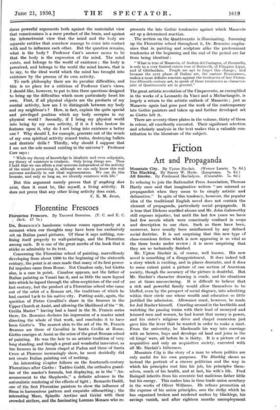Florentine Frescoes
Da} BOnENiUs's handsome volume comes opportunely at a moment when our thoughts may have been too exclusively set op Italian panel pictures. Of these -it says nothing, con- fining itself properly to wall-paintings, and the Florentine among such. It is one of the great merits of the book that it sticks so admirably to its text.
Concerning the Florentine school of painting, marvellously deyeloping from about 1300 to the beginning of the sixteenth century, the point is at once made that many of its first power- ful impulses came from Rome. Not Cimabue only, but Giotto also, is a case in point. Cimabue appears, not the father of Italian painting as Vasari has it, and as little the mere legend into which he lapsed through the ultra-scepticism of the end of last century, but the product of a Florentine school who came out of the orbit of a Roman art, the traditions of which he had,carried back to his native city. .Putting aside, again, the queition of Pietro Cavallini's share in the frescoes in the Upper Church at Assisi, and allowing the likelihood of the " St. Cecilia Master " having had a hand in the St. Francis series there, Dr. Borenius declares his impression of a master mind directing the whole of that work, and concludes it to have been Giotto's. The nearest akin to the art of the St. Francis frescoes are those of Cavallini in Santa Cecilia at Rome. Giotto emerges at Assisi as the scion of the great Roman school of painting. He was the heir to an artistic tradition of very long standing, and though a great and wonderful innovator, as the frescoes in the Arena chapel at Padua and those of Santa Croce at Florence increasingly show, he most decidedly did not create Italian painting out of nothing.
An interesting cLapter follows on the fourteenth-century Florentines after Giotto : Taddeo Gaddi, the orthodox guard- ian of the master's formula, but displaying, as in the " An- nouncement to the Shepherds," a definite advance in the naturalistic rendering of the effects of light ; Bernardo Daddi, one of the first Florentine painters to show the influence of Siena in harmonious pattern and exquisite silhouetting ; the interesting -Mos°, SpsnaI10 Aretino and Gerini with their crowded ateliers, and the fascinating Lorenzo Monaco who re-
presents the late Gothic tendencies against which Masaccio set up determined reaction. - .The section op the Quattrocento is, illuminating. Summing up the Florentine school throughout it, Dr. Borenius empha- sizes that in painting and sculpture alike the predominant tendencies at the beginning and the end of the period are far from being identical :
" What is true of Masaccio, of Andrea del Castagno, of Donatello, is only to a very limited extent true of Botticelli, of Filippino and of Ghirlandaio. People are apt to forget this change ) and because the next phase of Italian art, the mature Renaissance, makes a most definite reaction against the tendencies of late Floren- tine fifteenth-century art, to speak of those tendencies as character- istic of Quattrocento art in general."
The great artistic revolution of the Cinquecento, as exemplified in the works of a Leonardo da Vinci and a Michaelangelo, is largely a return to the artistic outlook of Masaccio ; just as Masaccio again had gone past the work of the contemporary late Gothic painters and taken up and further developed art as Giotto left it.
There are seventy-three plates in the volume, thirty of them in colour, all excellently executed. Their significant selection and scholarly analysis in the text makes this a valuable con- tribution to the literature of the subject. ,








































 Previous page
Previous page